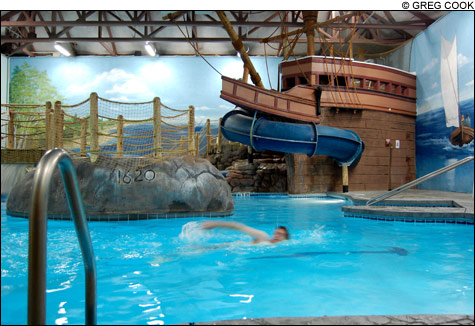
PURITAN POOL The author takes a dip in the Pilgrim Cove pool, swimming past the hot tub in a replica of Plymouth Rock. |
If you're looking for meaning in the overly sanitized myth that is our national Thanksgiving celebration, a good place to start is southeastern Massachusetts, where nearly 400 years ago that band of hungry, ill-prepared religious zealots tried to colonize the middle of nowhere at the start of winter. I commenced my own journey there, in Plymouth, at the top of an 80-foot waterslide, which would take me from the deck of a replica Mayflower into the cool waters of a shimmering blue pool.
The John Carver Inn, which is just a five-minute walk up from the Plymouth waterfront, is much like other ordinary motels, except that its swimming facility boasts a mural of Plymouth Harbor, that replica of the Mayflower jutting out from a wall, and, in the showcase center of the pool, a hot tub set in a replica of Plymouth Rock. What could be more American than that?
The Pilgrim Cove Indoor Theme Pool's waterslide ride was fast, wet, and a bit out of control. As I splashed into its chlorinated waters, it occurred to me that this was a quintessential 21st-century metaphor for what it must have been like, four centuries ago, to be a Pilgrim disembarking from the Old World into the New one.
Today, America seems ever more plastic and artificially flavored, filled with Rock Band simulations that promise a firsthand experience, but end up delivering an outsourced and re-imported lesser-quality one. It's akin to celebrating an autumnal cornucopia with (admittedly delicious) turducken and high-fructose corn syrup. I went to Plymouth looking for the untidy facts of the interaction between English immigrants, Native Americans, and the unforgiving New England soil; for reports of shifting alliances between frenemies; for the shadowy space between stories of a sacred quest for freedom and a bloody colonial invasion, in which the soul of the story resides. Scooting down the waterslide, I began to immerse myself in the Pilgrim experience to find out who they were — and how we've fooled ourselves for so long.
Rock star
The spiritual epicenter of Plymouth is, of course, Plymouth Rock, upon which the Pilgrims may or may not have landed in 1620. Its force radiates out through the Plymouth businesses you pass on the way there: the Colonial Restaurant; the Old Colony Auto School; the British Beer; the All American Diner; the Mayflower General Store; Pilgrim's Corner: Souvenirs, Tee-Shirts, Apparel, Gifts; the Governor Bradford Motor Inn; and the On the Rocks Tavern.
I pass the Mayflower II, a roomier version of the Pilgrim ship, tied up along the waterfront, and arrive at Plymouth Rock, almost exactly 389 years to the day when Pilgrims first landed at North America, at the tip of Cape Cod in Provincetown on the other side of the bay. It's a gray, overcast November afternoon. I stand at the rail beneath the 1921 neoclassical portico — erected to mark the 300th anniversary of the Pilgrim landing — and stare down at the stone. It has a scar where it was patched together and the year 1620 etched into its face. "It smells," a nearby young girl complains of the harbor aroma.